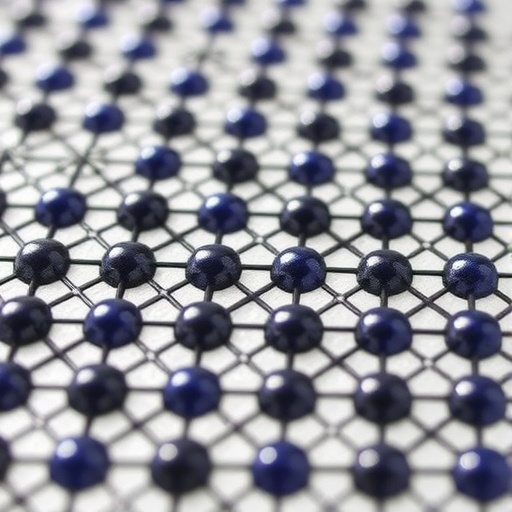In the world of electrocatalysis, the quest for efficient materials has led researchers to explore innovative compounds that can enhance energy conversion processes. One such study introduces cobalt-doped zinc oxide nanosheets, which have been found to exhibit remarkable bifunctional catalytic activity for both the oxygen reduction reaction (ORR) and the oxygen evolution reaction (OER). This dual functionality is essential for various applications, including fuel cells, metal-air batteries, and water splitting technology, highlighting the importance of developing catalysts that can effectively facilitate these critical electrochemical reactions.
The research conducted by Mondal and colleagues presents a detailed examination of cobalt-doped zinc oxide, abbreviated as Co@ZnO, showcasing its potential as a highly effective bifunctional electrocatalyst. The study delves into the synthesis and characterization of these nanosheets, providing insights into their structural properties and catalytic performance. By incorporating cobalt into the zinc oxide matrix, the researchers aimed to enhance the material’s electronic structure and surface properties, which are pivotal for improving its electrochemical efficiency.
Through advanced characterization techniques, the team confirmed the successful incorporation of cobalt into the zinc oxide framework. Techniques such as X-ray diffraction (XRD), scanning electron microscopy (SEM), and transmission electron microscopy (TEM) were employed to analyze the morphology, crystallinity, and surface area of the Co@ZnO nanosheets. The findings revealed a well-defined nanosheet structure that offers an increased surface area for catalytic reactions, which is crucial for achieving high performance in electrocatalysis.
Electrocatalytic activity was quantitatively assessed using cyclic voltammetry and chronoamperometry. The results demonstrated that the Co@ZnO nanosheets exhibited superior catalysis for the ORR and OER compared to their undoped counterparts. The cobalt doping was attributed to the enhancement in electron conductivity and active site availability, which significantly accelerates the kinetics of the electrochemical reactions. This discovery opens new avenues for the development of efficient electrocatalysts that can operate under practical conditions.
A notable advantage of the Co@ZnO nanosheets is their stability under various electrochemical conditions. The team conducted long-term stability tests, revealing that the cobalt-doped material maintained its catalytic performance over extended periods of operation. Such durability is critical for real-world applications, as it ensures that the electrocatalyst can perform effectively without significant degradation.
In addition to their catalytic properties, the Co@ZnO nanosheets also present an environmental benefit. Zinc oxide is a widely available and non-toxic material, which makes it a more sustainable choice compared to other precious metals commonly used in electrocatalysis. The researchers emphasize the importance of developing environmentally friendly catalysts that can contribute to the growing demand for renewable energy solutions.
Beyond practical applications, the study addresses the underlying mechanisms driving the improved performance of the Co@ZnO nanosheets. The researchers utilized density functional theory (DFT) calculations to simulate the electronic properties and to gain insights into the reaction pathways during the ORR and OER processes. This theoretical framework complements the experimental findings, providing a comprehensive understanding of how cobalt doping influences the electrocatalytic activity at the atomic level.
The search for bifunctional electrocatalysts like Co@ZnO is particularly timely as the global transition towards sustainable energy sources accelerates. The electrolyte systems used in fuel cells and batteries greatly benefit from catalysts that can efficiently manage both oxygen reduction and evolution. This dual functionality can lead to enhanced energy conversion efficiency, ultimately aiding in the reduction of reliance on fossil fuels and lowering carbon emissions.
As the research community continues to seek out innovative materials for energy applications, the findings surrounding Co@ZnO nanosheets stand as a promising advancement in the field of electrocatalysis. By fine-tuning the composition and structure of these systems, it may be possible to further enhance their performance and broaden their applicability across various electrochemical technologies. The study not only highlights the potential for cobalt doping in improving electrocatalytic efficiency but also underscores the essential role of ongoing research to unlock new possibilities in energy conversion.
In conclusion, the development of cobalt-doped zinc oxide nanosheets represents a significant step forward in the field of electrocatalysis. Their remarkable bifunctional activity, combined with structural stability and environmental benefits, positions them as a valuable material for future energy solutions. The ongoing exploration of such innovative compounds will be vital in the quest to meet global energy demands and combat climate change, paving the way for a sustainable and cleaner energy future.
Subject of Research: Cobalt-doped zinc oxides (Co@ZnO) nanosheets for electrocatalytic activity.
Article Title: Cobalt-doped zinc oxides (Co@ZnO) nanosheets for efficient bifunctional electrocatalytic activity for the oxygen reduction and evolution reactions.
Article References: Mondal, A., Pappula, V., Sinhamahapatra, A. et al. Cobalt-doped zinc oxides (Co@ZnO) nanosheets for efficient bifunctional electrocatalytic activity for the oxygen reduction and evolution reactions. Ionics (2025). https://doi.org/10.1007/s11581-025-06795-z
Image Credits: AI Generated
DOI: https://doi.org/10.1007/s11581-025-06795-z
Keywords: Cobalt-doped zinc oxide, electrocatalysis, bifunctional activity, oxygen reduction reaction, oxygen evolution reaction, sustainability.




